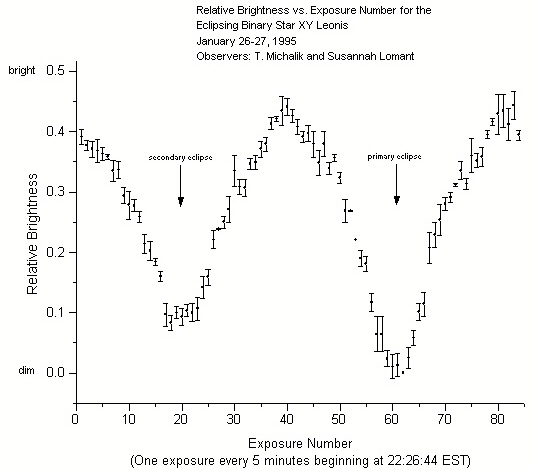
THE ECLIPSING BINARY STAR XY LEONIS
XY Leonis is about 170 light years away and consists of two stars each slightly smaller than our Sun. The two stars are so close together that they "touch" each other. Their centers are separated by only about 2.8 times the distance from the Earth to the Moon. The Earth and Moon take 27.3 days to orbit each other. Since the stars of XY Leonis are 430,000 times more massive than the combined Earth and Moon, the stars complete an orbit much quicker than the Earth and Moon do. XY Leonis completes an orbit in only 6 hours and 50 minutes!
On the winter night of January 26-27, 1995 physics major Susannah Lomant and I observed one complete orbit of this star system. We each wore long
underwear, coats, hats, gloves, and several layers of socks to help endure the cold.
Imaging began at about 10:30 PM, and an image was taken every five minutes until about
5:30 AM. This produced 84 images, each an exposure of 80 seconds. It also produced a very
tired professor who had no time to sleep before his 9:00 AM class that morning!
Measuring the brightness of XY Leonis on each of the 84 images was a long and sometimes
tedious process, but the result was a complete light curve showing both the primary and
secondary eclipses. The deeper primary eclipse occurs when the smaller star passes in
front of the larger star. The secondary eclipse ocurs when the larger star passes in front
of the smaller star. the light curve of XY Leonis is shown below.
An XY Leonis eclipse is much more spectacular than an ordinary solar eclipse! XY Leonis
consists of two gigantic nuclear fusion reactors, each almost 100 Earth diameters across.
These huge power sources are so close that they gravitationally distort each other's shape
away from that of a perfect sphere. Material actually flows from one star to the other!
There is a very good chance that Winfree Observatory was the only place on earth watching
these two stars pass in front of each other that night!
